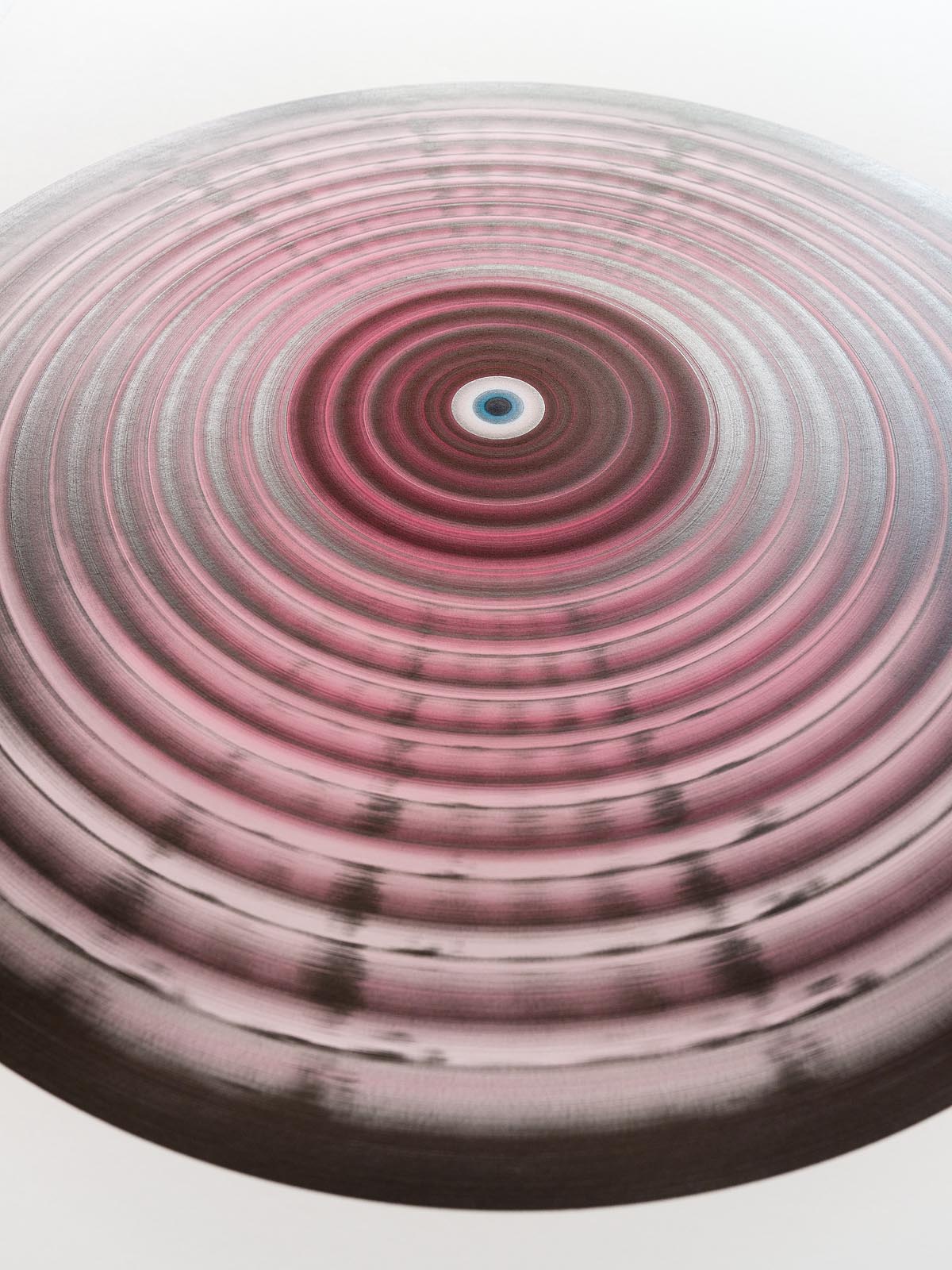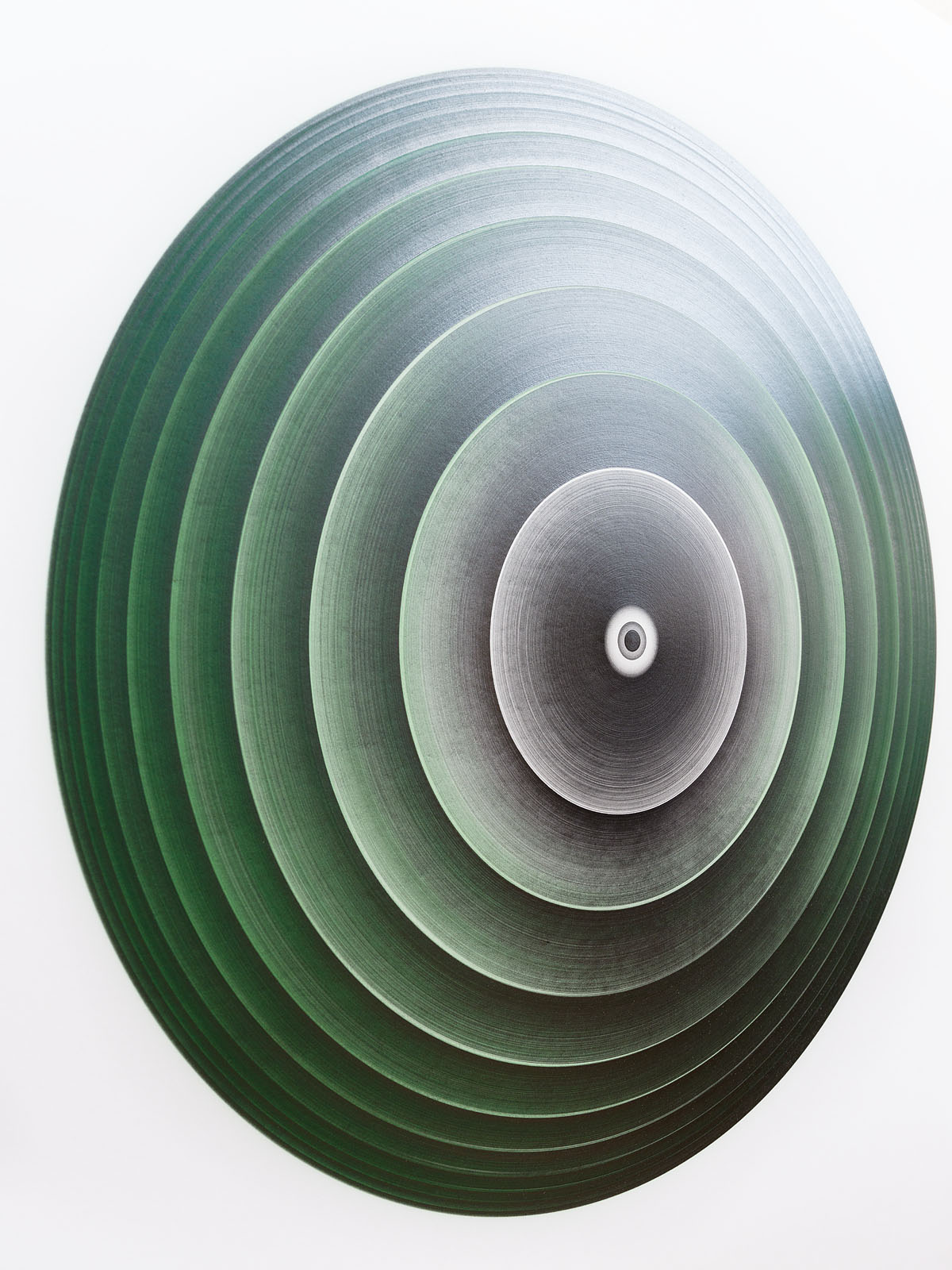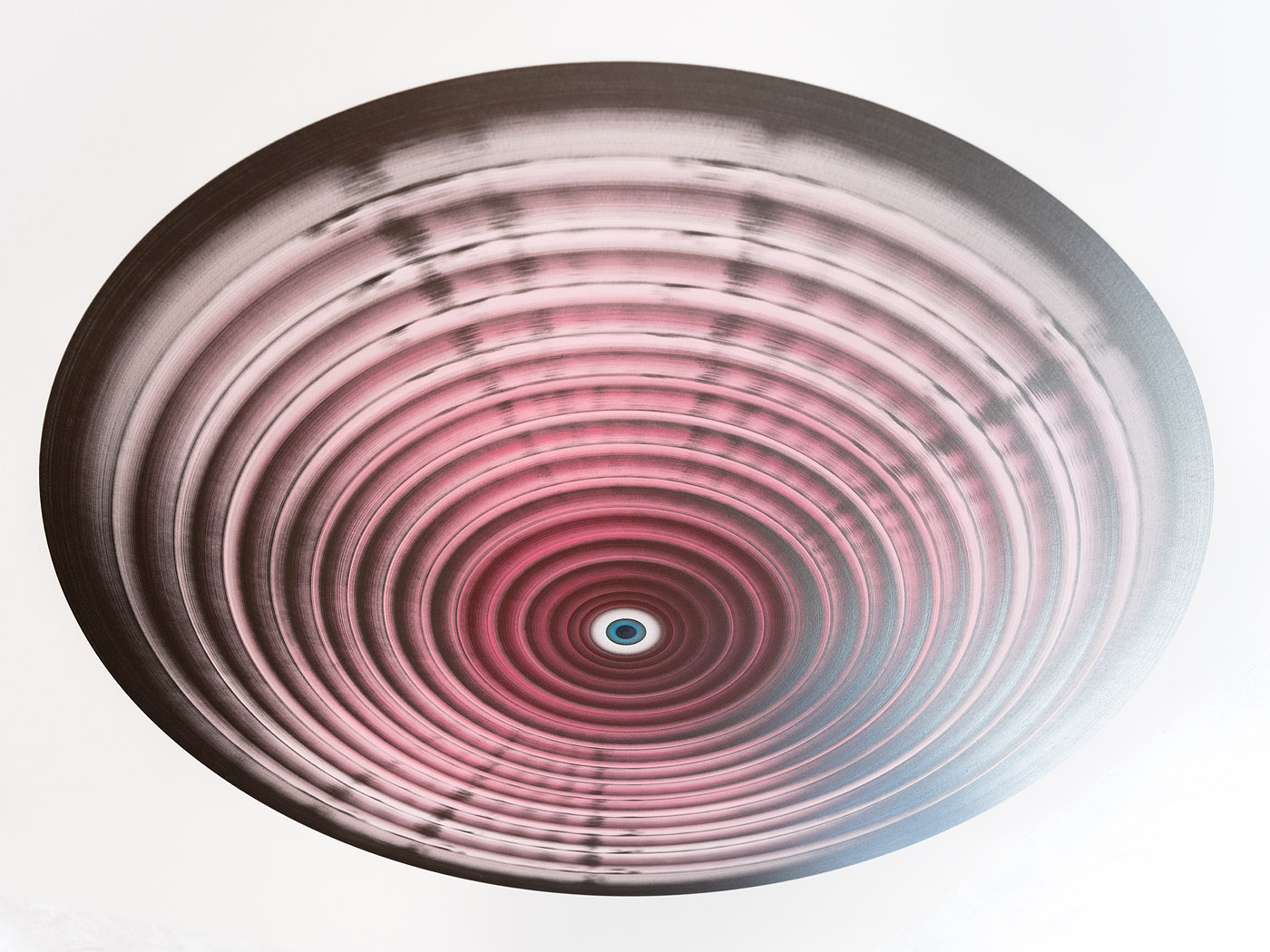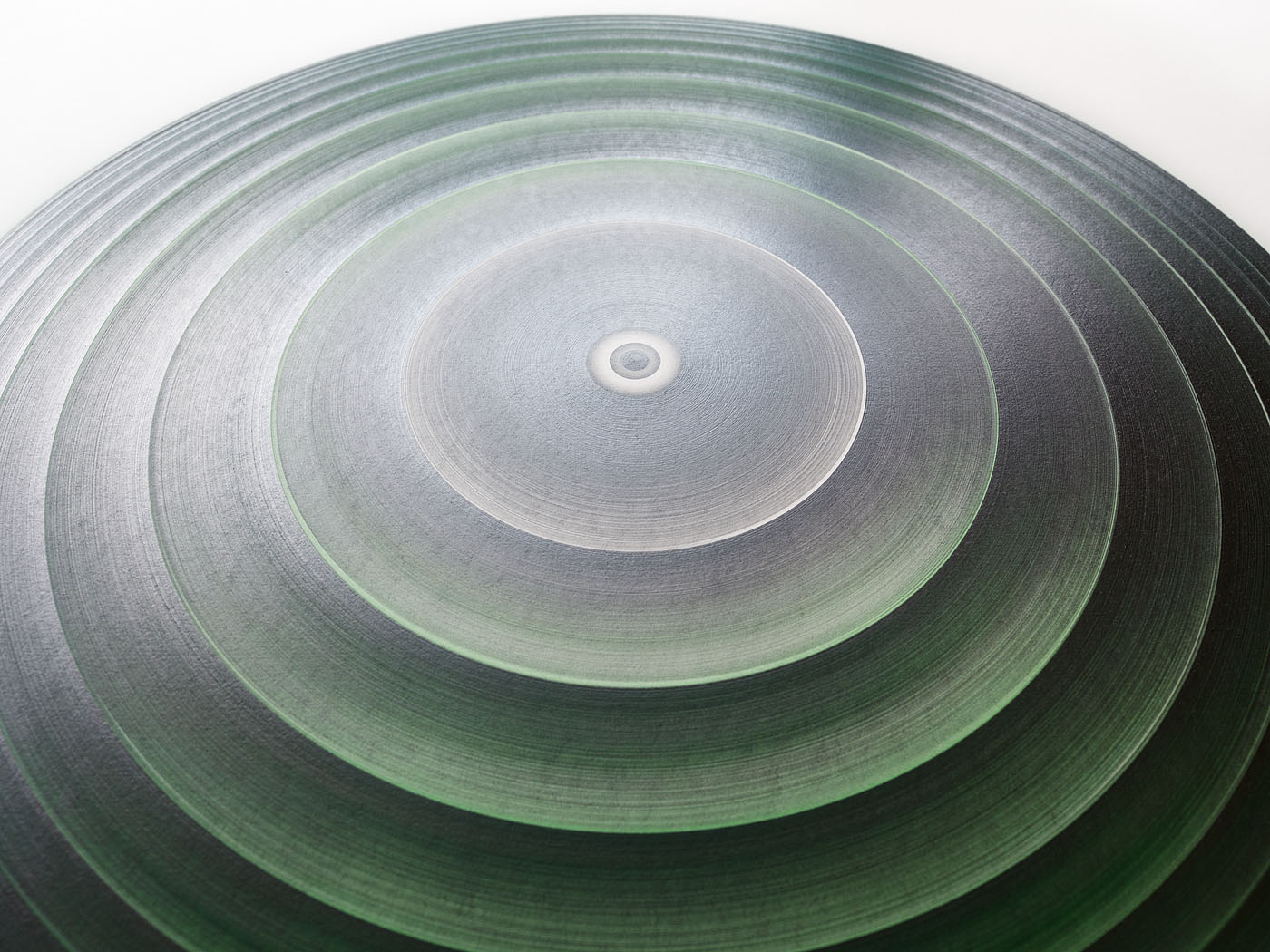2 Portrait Drawings
MAGGI (in red)
SELF-PORTRAIT (in green)
Sheet : 105 x 75cm 640gsm; graphite & pigment paint on 100% cotton Fabriano.
Frame : 113.5 x 83cm; welded aluminium, powder-coated; AR museum glass.
20 October 2018 – 6 January 2019
THE QUICK & THE DEAD
HAMBLING – HORSLEY – LUCAS – SIMMONS – TELLER
Jerwood Gallery, Hastings, UK
#thequickandthedead
What are they based on?
BLACK MILK, in colour.
A couple of years ago Maggi Hambling painted a portrait of me, bare chested (I was, not her), set against an abstract backdrop of my music – which Maggi was listening to while painting. What I didn’t know at the time – that the deal was reciprocal, for me to then make portrait of her (and also a self-portrait). So plainly these two drawings are that. They’re not abstractions – if that’s what you mean by ‘based on’. In terms of a ‘base’, they are as close as I can get to real-time recordings of disturbances in my consciousness or of immediate first thoughts. They are monitors, displays.
Are they an illusion?
Blatantly, I mean in terms of what’s filtered-out and what’s filled-in. When I photograph the drawings I’m guiding you how to look at the actual works (“loading” as Franz West would say). You’ll probably initially wish to look flat on, but most certainly I’d like you to look at the work somewhat obliquely. For 2D wall-pieces I notice most people do tend to shuffle their way to the perpendicular flat-on view, then stay there. I suggest you spend at least as much time to the side. I was going to subtitle my self-portrait, ‘STACK OF SAUCERS’.
Ok, the point about the notion or idea of illusion, is pointing to what isn’t. What isn’t there, usually.
If you point the other way, to what is there, with the same intention, then this notion of intention – either to the extreme of in or out – of normal perception, well then we have an exercise. It’s worth taking a dimension to it’s limits, to more clearly separate it’s components.
Point A – avoid looking at flat works flat-on, stand to the side! The same I believe should be true in catalogues. I encourage that flat works should be photographed from the side – which I realise is unpopular with publishers, so perhaps at least ‘details’ reproduced sidelong. (NB. I ensured the SELF-PORTRAIT drawing was reproduced in the exhibition catalogue from a photograph I took obliquely and also as a postcard an oblique detail of MAGGI. I hope that is noted and appreciated!)
Why are you fascinated by drawing?
Drawings are a particular exemplar of pointing to more dimensions than they exist in. They are often plans or maps – given to another person in order to ‘bring a whole world to mind’ – yet only from a few lines – in the most minimal way possible. They are supremely efficient at enfolding countless dimensions that strictly should be beyond them. Radial maps are useful devices to raise the notion of internal navigation – or inner-world sculpting, which sounds ephemeral but is entirely practical and everyday. Everything proceeds radially inward towards your eye.
As portraits, especially my self-portrait, they were seen more from, well, within the inside – looking out. Placing another eye behind one’s actual eye, not what you see in the mirror. A view perhaps including the ocular socket, optic nerve and some brain.
What’s the metallic sheen?
1000’s of layers – no exaggeration – of graphite, a thin section of mineral laid down and indented into the paper. I’ve offset the difference between the matte of the colour pigments and the silver nature of graphite to present this other dimension – that graphite is metallic, …especially in the MAGGI portrait where the central 1/3 is absorbingly matte. It’s vital that the works are lit to reveal this ‘specular geology’ – not mask it. The first week of each was taken gently pushing the paper-fibres down with a B grade pencil – smoothing, then I could apply more pressure and definition without risk of tearing the paper. Finally, soft-grade 2B & 4B pencils pressed very hard to achieve the darkest levels – this could not be done immediately. I have irrevocably torn the paper a few times. All of these presented drawings are just on that threshold, actually if you look very closely you’ll probably see a few micro-tears.
Your drawing – the pink one, it doesn’t look like Maggi.
To me, it’s the best portrait I’ve ever seen of Maggi.
I have my own predilections.
Evidently you don’t know her as well as I do …or see her as I do. While drawing this portrait I thought only of her, all aspects, my thoughts may have wandered – there’s probably some adulteration in there, I get the sense she fancies me. I offered to take my trousers off – go the whole way, she was more than content with my belly and tits. Maggi’s often remarking, “you look like you’re from baroque religious painting” – which I put down to wet, long, curly hair. Her portrait of me though, is a Greek satyr, or Green Man, with nice tits.
For Maggi (and I’m sure she’d extend this to every artist), ART BEGINS WITH SEX. That’s undulating all the time with Maggi – her sea paintings are writhing lustful bodies for Christ’s sake, of Maggi of course. You can tell she loves an orgasm. And yes we all notice her dominant eye – the left one, same as mine, the left one. I put it in the middle of her sex, water in a ring of fire.
Also her face, she has quite a rosy complexion; “you said I must have been in the sun and I said it was whisky.”
I’ve got into thinking about flesh for the first time (on paper), a flexible fatty bloody material, the human material that sculpts beauty over stick-man bone. Crimson red, you’ve got to like it. The pigment I used, chemically is Naphthol red, favoured for painting sports cars. Maggi loves big, powerful, gangster cars. When her partner tells her to slow down, Maggi exclaims, “what’s the point of having a fast car if you can’t put your foot down?!!”
I still don’t think it looks like Maggi.
When you listen to a piece of classical music written about a person, a tribute to them, it doesn’t sound like them at all, does it? – I mean how they talk or exhale etc, and it certainly can’t look like them, so what is it really ‘of’? The ‘musical portrait’, as an example, is liberating. I’d say this drawing is so Maggi …when she drills her immovable gaze into you knowingly engendering fright. There’s no beauty without terror. She stands her ground.
Maggi loves wearing a brooch, not your typical enamelled butterfly, god knows, a shaking pink lobster or some weird insect or reptile, a creature to horrify your pupils wide-open in fear (and reevaluate all cliche comments such as “what a lovely brooch”), a symbol of her sex of course – by sex I don’t mean gender. I’ve been thinking waves are like lips, though not emanating outward, more like repeatedly progressing inward to a locus horizon. Strength at an inner edge. The more edges the more strength. That’s the genius of waves.
Also this is the first time I’ve included radial striations in a drawing. Reflections on waves – though in negative – dark reflections, a devilish sundew, the Venus flytrap of Maggi’s mascara.
Why the black rim?
Maggi’s nostrils are prominent.
Not just the black rim, but also the folded intensity of the concentric rings in the drawing. Maggi has powerful and iconic nasolabial folds (from the nostrils down), marionette lines (from the mouth down) and deadly serious jowls.
Maggi loves TV murder-mysteries – all that selubrious character mixing, ambiguous liaisons and motives, flamboyant costumes, communes (strangers trapped in a remote house or stranded train etc), power-cuts, ridiculous behaviour, innuendos and addiction to humorous intellect. I saw you before you saw me – if that’s possible. Eye eye.

: MAGGI, graphite & pigment on 105 x 75cm 640gsm Fabriano paper, unique, signed & dated [available for purchase, framed]

: SELF-PORTRAIT, graphite & pigment on 105 x 75cm 640gsm Fabriano paper, unique, signed & dated [available for purchase, framed]
‘Terrific… we are as one in the tit department’, Maggi Hambling.
‘Simmons’s ‘MAGGI’ is a vortex of concentric circles, centred on an open blue eye that stares down Hambling’s own painting of Simmons on the opposite wall – topless and beside the eye of a whirlpool. According to Hambling, the idea to have him pose like this came after a departing hug at a party: ‘I felt his tits. I said, “great tits.” I must have your tits in a painting’, Thomas McMullan, DRUGSTORE CULTURE.
‘The puckish Simmons appears in Hambling’s painting bare chested, backed by flickering brushstrokes and paired with a painting of a swirling whirlpool, while he distills her image to a single staring eyeball, surrounded by a target of concentric graphite rings. The solitary piercing blue orb forms the highly disconcerting epicentre of Simmons’s elegant shimmering circles’, Louisa Buck, The Art Newspaper.
From the exhibition press-release…
Julian Simmons, born in London, 1971, still uses a USSR binocular-head Biolam microscope given to him in 1980. With an oil-immersion achromat 90x objective lens, it has molded him ever since. Inspecting either diatoms, vorticella, rotifers, sperm or pollen grains, a biography from the nutshell. He was a student and visiting lecturer at the RCA, developed a programmable electronic drawing machine and received a doctorate in Fine Art on the Cosmology of Tone (2004). He moved to Suffolk (2007) where he now lives and works.
In 2011 he began building experimental sound synthesis instruments employing a language known as Pure-Data, designed at IRCAM / founded by Pierre Boulez. During live performances these NUMBERSTREAM instruments are gesturally moved rotationally and radially within quadraphonic speaker environments in real-time, as he says ‘for the purpose of elevation’. In a radio interview Sarah Lucas remarking on the audio piece THE SLIDER, observed, “It’s like finding yourself outside at night… in front of the heavens… and the whole of reality drops away”. He has performed quadraphonically in London, Suffolk, Milan and Oslo.
The Orbicular Drawings first seen in the show NOW JULIAN SIMMONS, 2015, continue this encircling exploration, visually, with pencil lead. He considers these drawings to be time-based self-portraits. Line recordings of basic perturbations in consciousness, over the time taken to make them; replayed though your observation. An objective, which also includes that of the quadraphonic works, is that he ‘considers them to be vehicles for installing new perceptions in the beholder’. Give and take: at the centre of the drawings is either the white of a nipple or the black of an eye’s pupil.
Sarah Lucas who he has worked with over the past several years, said, “The thing about Julian is that he sees things in greater detail than anyone else I know. Good for us that he’s also on a mission to show us how he does see it. How to see. For me especially, as we’re working so closely together. He’s a Star-man with a pair of binoculars.”
“He doesn’t care much for cities …because he’s very interested in the natural world – he’s really tuned-in both visually and in an audio way to the minute things that other people don’t pick up. So he’s very attuned to insects or birds – he can hear mice when I can’t hear them. He can never hear what I’m saying, you know even if I’m right next to him, he’ll say “what?” he’ll get it completely wrong! – but if there’s a mouse squeaking somewhere in the grass he’ll hear that …you know …he’ll just pick it up.”
Today he was trapping flower-intent pollen beetles while considering mascara, the microcosm, overstanding, and laying the round egg.
Can I interject and ask you – what actually is the round egg??
Sure, it’s the mundane egg.
But be careful about mundane – what you mean by it. Mundane may seem like ‘every-day’, but it’s the whole world. It’s completely beautiful, …it’s the common egg – the humongous every-world.
BLACK MILK : Atlas of Orbicular Drawings.

